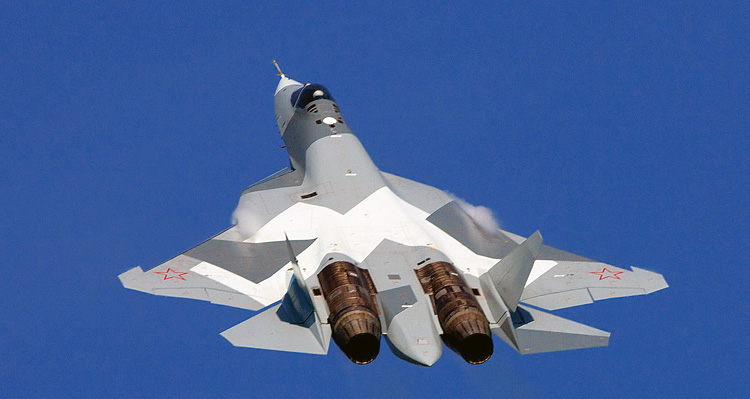INDIAN ARMED FORCES CHIEFS ON
OUR RELENTLESS AND FOCUSED PUBLISHING EFFORTS

SP Guide Publications puts forth a well compiled articulation of issues, pursuits and accomplishments of the Indian Army, over the years

I am confident that SP Guide Publications would continue to inform, inspire and influence.

My compliments to SP Guide Publications for informative and credible reportage on contemporary aerospace issues over the past six decades.
FGFA for the IAF
On account of the technological, capability and price issues, the IAF was clearly unhappy with the platform and was keen that the project be called off
 | By Air Marshal B.K. Pandey (Retd) Former Air Officer Commanding-in-Chief of Training Command, IAF |

India’s quest for a combat aircraft from a foreign source to enable the Indian Air Force (IAF) to foray into the fifth generation, began on January 26, 2007, when President Vladimir Putin visited India as the Chief Guest at the Republic Day Parade in New Delhi. The visit, which was the first by a Russian head of state, went far beyond being merely ceremonial, as a number of agreements between India and Russia in the fields of energy, defence and space were signed. One of these was the agreement for an Indo-Russian collaboration project to develop a Fifth-Generation Fighter Aircraft (FGFA), customised to the needs of the IAF. The agreements in the domain of aerospace and defence were extremely important for the Russian aerospace and defence industry as well, because Russia was keen to remain in the number one slot in the world as supplier of military hardware to India. Besides, India was expected to spend as much as $30 billion on defence procurement in the 11th Plan period from 2007 to 2012, a potential that Russia would do everything to exploit. Besides, with the breakup of the Soviet Union and the emergence of a uni-polar world, India was no longer dependent only on Russia as the nation was free to explore other suppliers as well. This paradigm shift would have been a matter of serious concern for Russia.
The plan drawn up in the dialogue in the initial three years between India and Russia, was to develop a twin-seat version of the Russian T-50 PAK FA for the IAF. The single-seat version of this fifth-generation platform designated as the T-50 PAK FA was already under development in Russia. However, the requirement of the IAF was for a platform capable of a carrying heavier payloads and a larger radius of action. The version to be developed for the IAF was called the Perspective Multirole Fighter (PMF).The project would require an investment of $6 billion, with a work-share of 50:50 with the state-owned Hindustan Aeronautics Limited (HAL) as the Indian partner. The timeframe for development of the FGFA was estimated as 10 years. A memorandum of understanding for preliminary design work for the FGFA requiring an investment by India of $295 million, was signed In December 2010 between HAL and two Russian companies Rosoboronexport and Sukhoi. The preliminary design work phase was completed in 2013; but thereafter, there have been no progress in the project.
The plan drawn up in the dialogue in the initial three years between India and Russia, was to develop a twinseat version of the Russian T-50 PAK FA for the IAF.

In December 2014, it was for the first time that the IAF apprised the Ministry of Defence (MoD) about the inadequacies in the proposed FGFA on account of which it did not consider the platform suitable for induction. The IAF evaluated the first prototype of the T-50 PAK FA and was of the view that the aircraft had a number of deficiencies that were not acceptable to the IAF. After an in depth assessment over the next couple of years, the IAF catalogued weaknesses in the FGFA. Firstly, the AL-41F1 engine that was fitted on the FGFA was somewhat under powered to meet with the performance parameters of a fifth-generation platform as also was not reliable enough. The AL-41F1 was not a power plant developed specifically for this fifth-generation platform, but was a mere upgrade of the AL-31 that powers the Su-30 MKI that was a platform of the previous generation. More importantly, the IAF felt that the platform on offer did not have the capability attributes that the IAF was looking for. Capability of its radar was inadequate as it did not provide the desired coverage and the IAF would have preferred the new platform to be fitted with an AESA radar instead. The stealth features of the airframe were badly engineered and the capability of the aircraft in this regard left considerable room for doubt. The aircraft needed to be equipped with high technology advanced sensors, better networking capability, more advanced combat avionics and super cruise capability. As listed by the IAF, in all, there were more than 40 parameters related to the features of the aircraft and its performance that required improvement and that it would be the responsibility of the Russians to do this.
The IAF also observed that contrary to the agreement, there was no transfer of technology as the Russians were reluctant to share critical design information with India. Besides, work share of HAL was much lower than that originally agreed upon at 50:50. The list of improvements required in the aircraft drawn up by the IAF was indeed large and would only serve to aggravate the steep and continuous escalation in the price. This, in all likelihood, would render the platform unaffordable price wise in the long run making it impossible for the IAF to induct this fifth-generation platform in the numbers required. The Russians were now demanding in excess of $7 billion as against the originally agreed sum of $3 billion as part of India’s share in the development of the FGFA. On account of the technological, capability and price issues, the IAF was clearly unhappy with the platform and was keen that the project be called off.
Unfortunately, today, both the MoD and the HAL are not prepared to accept the IAF’s viewpoint. While for the MoD, the FGFA project has become a politically sensitive as well as a prestige issue, for HAL, it was more an issue of their survival. Since the Su-30MKI project will be completed in the next few years, the Indian aerospace major is looking for another major aircraft project for its survival. Given the fact that the tender for 126 medium multi-role combat aircraft has been cancelled and other projects such as for building single engine combat aircraft in India in large numbers under the ‘Make in India’ programme not moving forward, HAL is keen that the FGFA project would come as a saviour and ought not to be cancelled. HAL is also of the view that the experience gained with the FGFA project will ultimately help develop the indigenous Advanced Medium Combat Aircraft (AMCA) which is still on the drawing board and currently with an uncertain future.
Whatever may be the compulsions, political or otherwise, in the final analysis, it would not be prudent to disregard the professional assessment by the IAF to arrive at a final decision on the future of the FGFA project.





